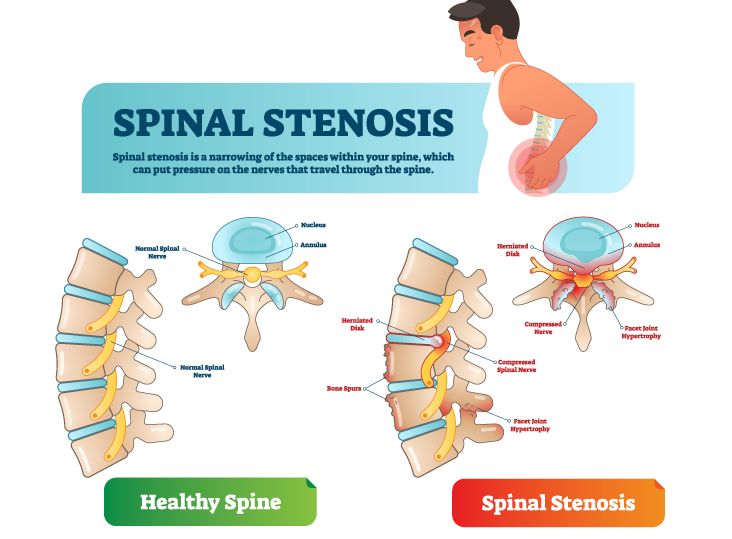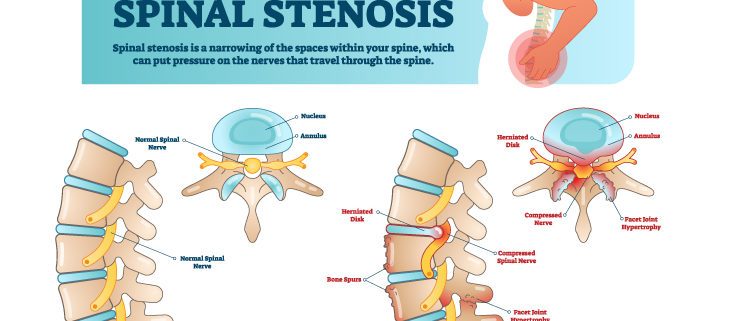What is Spinal Stenosis?
 From WebMD
From WebMD
Cervical Spinal Stenosis
Spinal stenosis is a condition, mostly in adults 50 and older, in which your spinal canal starts to narrow. This can cause pain and other problems.
Your spine is made up of a series of connected bones (or “vertebrae”) and shock-absorbing discs. It protects your spinal cord, a key part of the central nervous system that connects the brain to the body. The cord rests in the canal formed by your vertebrae.
For most people, the stenosis results from changes because of arthritis. The spinal canal may narrow. The open spaces between the vertebrae may start to get smaller. The tightness can pinch the spinal cord or the nerves around it, causing pain, tingling, or numbness in your legs, arms, or torso.
Causes
The leading reason for spinal stenosis is arthritis, a condition caused by the breakdown of cartilage — the cushiony material between your bones — and the growth of bone tissue.
- Herniated discs. If the cushions are cracked, material can seep out and press on your spinal cord or nerves.
- Injuries. An accident may fracture or inflame part of your spine.
- Tumors. If cancerous growths touch the spinal cord, you may get stenosis.
- Paget’s disease. With this condition, your bones grow abnormally large and brittle. The result is a narrowing of the spinal canal and nerve problems.
Some people are born with spinal stenosis or diseases that lead to it. For them, the condition usually starts to cause problems between the ages of 30 and 50.
Symptoms
Spinal stenosis usually affects your neck or lower back. Not everyone has symptoms, but if you do, they tend to be the same: stiffness, numbness, and back pain.
More specific symptoms include:
- Sciatica. These shooting pains down your leg start as an ache in the lower back or buttocks.
- Foot drop. Painful leg weakness may cause you to “slap” your foot on the ground.
- A hard time standing or walking. When you’re upright, it tends to compress the vertebrae, causing pain.
- Loss of bladder or bowel control. In extreme cases, it weakens the nerves to the bladder or bowel.
If you’re having symptoms, you might want to talk them over with your doctor. If you’re having a loss of bladder or bowel control, call your doctor at once.
Diagnosis and Tests
When you visit your doctor, she’s likely to ask you questions about your medical history. After that, she might order at least one of the following tests to figure out whether you have the condition:
- X-rays. These can show how the shape of your vertebrae has changed.
- Magnetic resonance imaging(MRI). By using radio waves, an MRI creates a 3-D image of your spine. It can show tumors, growths, and even damage to discs and ligaments.
- Computerized tomography (CT scan). A CT scan uses X-rays to create a 3-D image. With the help of a dye injected into your body, it can show damage to soft tissue as well as issues with your bones.
Treatment
Your doctor may start off with nonsurgical treatments. These might include:
Medication: Common pain remedies such as aspirin, acetaminophen , ibuprofen, and naproxen can offer short-term relief. All are available in low doses without a prescription. Other medications, including muscle relaxants and anti-seizure medications, treat aspects of spinal stenosis, such as muscle spasms and damaged nerves.
Surgery
Some people have severe cases. They struggle to walk or have issues with their bladder and bowel. Doctors may recommend surgery for these people. Procedures such as laminectomy and laminoplasty create space between the bones so inflammation can go down.
What You Can Do at Home
Some things you can do to help ease symptoms of spinal stenosis include:
- Exercise. Think about moderation — not 100 push-ups. Just take a 30-minute walk every other day. Talk over any new exercise plan with your doctor.
- Apply heat and cold. Heat loosens up your muscles. Cold helps heal inflammation. Use one or the other on your neck or lower back. Hot showers are also good.
- Practice good posture. Stand up straight, sit on a supportive chair, and sleep on a firm mattress. And when you lift heavy objects, bend from your knees, not your back.
- Lose weight. When you are heavier, there will be more pressure on your back.
The Orthopedic & Sports Medicine Center of Oregon is an award-winning, board-certified orthopedic group located in downtown Portland Oregon. We utilize both surgical and nonsurgical means to treat musculoskeletal trauma, spine diseases, sports injuries, degenerative diseases, infections, tumors and congenital disorders.
Our mission is to return our patients back to pain-free mobility and full strength as quickly and painlessly as possible using both surgical and non-surgical orthopedic procedures.
Our expert physicians provide leading-edge, comprehensive care in the diagnosis and treatment of orthopedic conditions, including total joint replacement and sports medicine. We apply the latest state-of-the-art techniques in order to return our patients to their active lifestyle.
If you’re looking for compassionate, expert orthopedic surgeons in Portland Oregon, contact OSM today.
Phone:
503-224-8399
Address
17355 Lower Boones Ferry Rd Suite 100A
Lake Oswego, OR 97035
Hours
Monday–Friday
8:00am – 4:30pm



